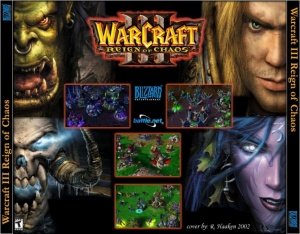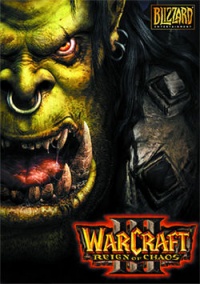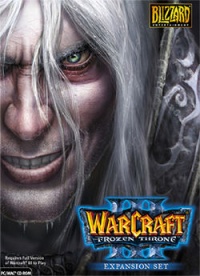Warcraft III
|
Warcraft III is a real-time strategy game developed and published by Blizzard Entertainment. It is the third set of games to the Warcraft series, with Warcraft III: Reign of Chaos releasing in July 2002, and an expansion pack, Warcraft III: The Frozen Throne, releasing a year later in July 2003. It is widely considered one of the most successful and popular real time strategy games to date, only rivaled by Blizzard's StarCraft series.[1] Like many other video games, Warcraft III has its own set of ethical issues such as trolling, online cheating, and unmoderated, inappropriate content.
Contents
Overview
The main objective of the game, just like most real-time strategy games, is to build a city while creating units to eventually destroy the opponent's army and city. There are a few ways for a player to win a game; the most common being killing the opponent's army. The longer routine is by destroying all of the enemy's buildings, thereby winning the game by default. In Warcraft III, there are many aspects to the game which allow players to customize their strategies and create personal playing styles. In July 2003, Blizzard released Warcraft III: The Frozen Throne, the expansion pack for Warcraft III: Reign of Chaos. This expansion pack introduced a handful of new units, four new heroes, and slightly modified game play.
Races
In Warcraft III, there are four races from which players can choose from, two more than the previous Warcraft game which only had two, Humans and Orcs. The two new races that were added in Warcraft III are the Night Elf and the Undead. Every race has their own strengths, weaknesses, and special perks. Usually, a player will have a specific race that is their "main," or best race which they play the most and have the best knowledge of.
Human
The Humans are usually considered to be the most versatile race amongst players in the Warcraft community. Their wide variety of units allows them to have the largest selection of strategies, and thus making them unpredictable. They have both a strong military and powerful magic to defend their kingdoms.
Orc
The Orcs are considered to be the brutes of the Warcraft series, and thus have the best melee units. In order to compensate for their strong melee units, they are do not have as many options for ranged support or air support units as compared to the other races.
Night Elf
Newly introduced in Warcraft III, the Night Elves are a very unique race focusing on semi-weak but very strategic units. They were the first race to awaken in the World of Warcraft as well as the first to study magic. Certain female Night Elf units have the ability to cloak in the night, rendering them invisible to the enemy while standing still. Many of their units have special abilities which can turn the tides in battle. For example, their best melee unit is also a spell caster, a very unique combination. The Night Elves' misuse of magic drew the Burning Legion into the world and led to a war between two races, causing their homeland to be engulfed by the sea. Since then, they vowed to refuse use magic, because they are afraid that the Legion would return.
Undead
The Undead race, also called the Scourge, is a new race in Warcraft III, focusing on a semi-versatile unit composition with high damage output. They consist of thousands of walking corpses. The Undead buildings create blight, which spreads as the player creates more buildings. Undead units regenerate health while standing/hovering over blight, but do not regenerate on normal land.
New Features
Warcraft III added a variety of new features to the game play of the Warcraft series, including heroes, items, and creeps.
Heroes
In addition to creating normal units, a player can also train up to three heroes to add to their army. Heroes are stronger than regular units and have special abilities that can be learned as they develop throughout a game. If a hero dies, the player can revive them for a certain amount of resources which depends on the level of their hero. Heroes can hold up to six items in their inventory, these items can offer perks such as, stat boosts, or even unique abilities. In Warcraft III: The Frozen Throne, each race has four heroes, all with different abilities and perks. The heroes grow throughout the game based on their experience, which they gain whenever they kill enemy units or creeps.
Items
Items play a very large role in Warcraft III, having the ability to influence games enough to cause wins or losses. There are many different types of items, such as potions, scrolls, weapons, armor, orbs, and many more. Potions are generally used to heal units or heroes, and only affect a particular individual unit. Scrolls are similar to potions but affect all the units around the individual who uses it. Weapons and armors give damage and defense to the individual holding it, while orbs give special effects to a hero's attack, such as splash damage or poison.
Creeps
On every map in Warcraft III, there are various creep units which are located in designated spots around the map. These units are computer controlled and will not attack you unless provoked, or if the player gets too close to them while they are awake. Players can kill these creep units for their heroes to gain experience. Creeps also drop items upon death, with the quality of the item depending on how strong the creeps are. The process of killing creeps, or more commonly known as creeping, is a very important part of the game as it can give a player an advantage over their opponent with higher level heroes or better items.
Online Environment
Warcraft III provides all of its users with a very developed online environment to interact with each other. The online environment which they provide is commonly known as Battle.net and promotes anonymity amongst its users. In order to use Battle.net, all the user needs to do is create an online alias, with no other information required. Battle.net provides users with a completely new experience, allowing clan support, chat channels, custom games, and an advanced match-making system.
Clan Support
On Battle.net, a user can create a new clan by gathering ten people and choosing an available clan tag which can be up to four characters. The clan tag and clan name can be anything the user desires, as long as it is not profane and fits in the allotted space. When a user joins a clan, the tag appears next to the user's name in chat channels, and thus people can easily identify players with their clans. Each clan is given a designated chat channel and can decide their own hierarchy within the clan. Within the clan, there is one leader, or "chieftain," who is the main owner of the clan, and there are five possible "shaman," who are one step under the chieftain but can govern the chat channel and invite/remove members. The only thing that the chieftain can do that the shaman cannot is disband the clan and choose the shamans. There are many famous clans on Warcraft III which have very populated chat channels and are extremely exclusive due to their popularity, and also because clans only support up to 100 members. Clan tags are often seen as a good identifier of a player's skill.
Custom Games
In addition to the normal ladder games on Warcraft, users can create their own maps and game modes using the World Editor. There are essentially endless custom games to choose from on Warcraft, and there are many well known and famous ones. The most popular custom game in Warcraft is Defense of the Ancients, or better known as DotA. DotA was created using Warcraft's World Editor, and has since then become a world wide phenomenon. Valve is currently producing and soon releasing DotA 2, a game that is completely based on Warcraft's DotA but run on Steam. DotA 2 is being developed by the same person who created DotA on Warcraft. In addition to DotA 2, there have been various games which mimic the game play and mechanics of DotA, such as League of Legends and Heroes of Newerth.
Many users on Warcraft III do not even play ladder games, but simply play custom games that they found or that they create. Since there are so many custom games to choose from, it is almost impossible to play all of them without finding one that is fun.
Ethical Controversy
- See also: Ethics in Computer & Video Games
Trolling
Due to the anonymity and the chat channel support that Battle.net provides to all of its users, there is a lot of trolling that occurs. In almost any populated channel, there will be people arguing or trash-talking. Also, there is much more trash-talking during games, much of it to aggravate the opponents or simply just to troll. With an anonymous online environment and little moderation, it is virtually impossible to stop the act of trolling, except by ignoring them, which is a feature that Battle.net does provide. Battle.net does provide a feature that will kick the person offline or from a chat channel if spamming or typing too much in a short amount of time. However, this is a brief prevention as the player can just login again and continue Griefing.
Cheating
Blizzard is a fierce advocate for fair competition; they take high measures to prevent cheating of any kind in competitive games such as on Battle.net. For example, they randomly monitor custom games and ranked games to actively prevent cheating. However, cheating does occur, both in offline games (in the form of cheat codes) and in online games. This introduces ethical complications found in any competitive video game, as players engage in competition expecting a fair playing field, and if other players are cheating, the fairness is violated. See Cheating. While the aspect of cheating in online games, especially competitive games, is a major concern, Warcraft III does offer in-game cheats for offline games that allow the player to gain advantages over computer players. Popular cheat codes include "whosyourdaddy" which allows the player to enter a god-mode in which their units are invincible and automatically destroy an opponent's troops or buildings. Other cheat codes include "warpten" which speeds up the game and "greedisgood" which gives the player more resources. These offline cheating methods are placed into the game to create more fun options for players.
In addition to random monitoring, Battle.net employs an anti-cheating tool, named Warden, to help detect hackers and ban cheaters[2]. The Warden detects certain programs that are running on users' computers and sends the information to Blizzard servers, which will in turn kick the user off if any hacks or prohibited third party programs are found. Although the Warden service does eliminate some cheaters, there are still many types of third party programs that are made to specifically bypass Warden's detection. These undetectable hacks are generally only attainable by purchasing them from the creator themselves, since they require a key to activate. Most hacks are sold for between 20 USD and 50 USD and are available to whoever is willing to spend the money. These programs allow the user to gain advantages which normal players would not be able to access in the boundaries of the game, such as extra resources, visibility of the entire map, ability to disconnect other players from the game, and many more exploitive features. Since these programs are undetectable by the Warden, these players usually go unpunished unless they are caught by Battle.net staff during the act.
Inappropriate Content
There are also various explicit chat channels on Battle.net that are not moderated. The most prominent example is the chat room named "sex" which constantly has 40 users, the limit on chat rooms. Due to its popularity, various rooms such as "sex2" and "sex3" are usually full as well. The conversations that take place in these rooms are not moderated and are dangerous because there are no restrictions from entering the room, thus allowing elementary and middle school children who are playing the game to wander into these chat rooms. This could potentially be scarring to younger children who get exposed to such inappropriate content. Furthermore, it has been speculated that many people pretend to be of the other sex to engage in sexual conversation in these channels. Thus, the anonymity of these chat rooms allows users to abuse their online identities and creates ethical concerns for unmoderated and inappropriate content.
See Also
- Blizzard Entertainment
- Cheating in Videogames
- Diablo II
- Diablo III
- Electronic Sports
- Starcraft II
- World of Warcraft
External Links
References
- ↑ Top Ten Real-Time Strategy Games of All Time. gamespy.com. Retrieved 11 December 2012.
- ↑ Battle.net Warden




